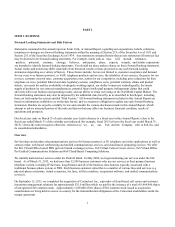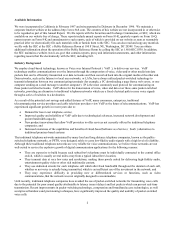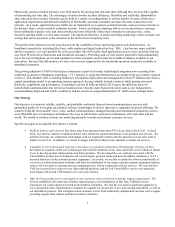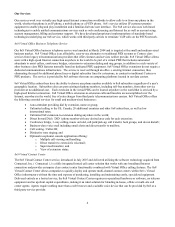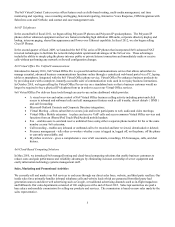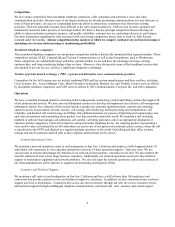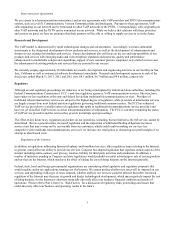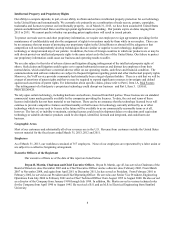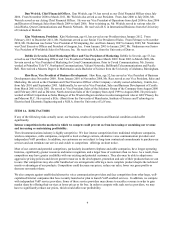8x8 2013 Annual Report Download - page 13
Download and view the complete annual report
Please find page 13 of the 2013 8x8 annual report below. You can navigate through the pages in the report by either clicking on the pages listed below, or by using the keyword search tool below to find specific information within the annual report.
11
We have a history of losses and are uncertain of our future profitability.
We recorded operating income of approximately $23.6 million for the fiscal year ended March 31, 2013 and ended the period
with an accumulated deficit of $109 million. We recorded operating income of approximately $7.2 million and $6.2 million
for the fiscal years ended March 31, 2012 and 2011, respectively. Although we have achieved operating income in each of our
four most recent fiscal years, we suffered operating losses in each of the three prior fiscal years and may incur operating losses
in the foreseeable future, which may be substantial. As we expand our geographic reach and service offerings, and further
invest in R&D, we will need to increase revenues in order to generate sustainable operating profit. Given our history of
fluctuating revenues and operating losses, we cannot be certain that we will be able to maintain operating profitability on an
annual basis or on a quarterly basis in the future.
Our business depends on continued, unimpeded access to the Internet by us and our users, but Internet access
providers and Internet backbone providers may be able to block, degrade or charge for access to or bandwidth use of
certain of our products and services, which could lead to additional expenses and the loss of users.
Our products and services depend on the ability of our users to access the Internet, and certain of our products require
significant bandwidth to work effectively. Currently, this access is provided by companies that have significant and increasing
market power in the broadband and Internet access marketplace, including incumbent telephone companies, cable companies
and mobile communications companies. Some of these providers offer products and services that directly compete with our
own offerings, which give them a significant competitive advantage. Some of these providers have stated that they may take
measures that could degrade, disrupt or increase the cost of user access to certain of our products by restricting or prohibiting
the use of their infrastructure to support or facilitate our offerings, or by charging increased fees to us or our users to provide
our offerings, while others, including some of the largest providers of broadband Internet access services, have committed to
not engaging in such behavior.
On December 23, 2010, the FCC adopted an order that imposes "network neutrality" obligations on providers of fixed and
wireless broadband Internet access services, with wireless providers subject to a more limited set of rules. Among other things,
the rules: (1) require providers of consumer broadband Internet access to publicly disclose their network management practices
and the performance and commercial terms of their broadband Internet access services; (2) prevent broadband Internet access
providers from blocking lawful content, applications, services, or non-harmful devices, subject to reasonable network
management; and (3) prevent broadband Internet access providers from unreasonably discriminating in the transmission of
lawful network traffic over a consumer's broadband Internet access service. The FCC rules became effective on November 20,
2011. Numerous parties have appealed these rules which have been consolidated before the U.S. Court of Appeals for the
District of Columbia. We cannot predict the outcome of these appeals or the impact of these rules on our business at this time.
Although we believe interference with access to our products and services is unlikely, broadband Internet access provider
interference has occurred, in limited circumstances in the U.S., and could result in a loss of existing users and increased costs,
and could impair our ability to attract new users, thereby negatively impacting our revenue and growth.
The VoIP telephony market is subject to rapid technological change, and we depend on new product and service
introductions in order to maintain and grow our business.
VoIP telephony is an emerging market that is characterized by rapid changes in customer requirements, frequent introductions
of new and enhanced products, and continuing and rapid technological advancement. To compete successfully in this emerging
market, we must continue to design, develop, manufacture, and sell new and enhanced VoIP telephony software products and
services that provide increasingly higher levels of performance and reliability at lower cost.
Decreasing telecommunications rates and increasing regulatory charges may diminish or eliminate our competitive
pricing advantage.
Decreasing telecommunications rates may diminish or eliminate the competitive pricing advantage of our services, while
increased regulation and the imposition of additional regulatory funding obligations at the federal, state and local level could
require us to either increase the retail price for our services, thus making us less competitive, or absorb such costs, thus
decreasing our profit margins. International and domestic telecommunications rates have decreased significantly over the last
few years in most of the markets in which we operate, and we anticipate these rates will continue to decline in all of the
markets in which we do business or expect to do business. Users who select our services to take advantage of the current
pricing differential between traditional telecommunications rates and our rates may switch to traditional telecommunications
carriers if such pricing differentials diminish or disappear, however, and we will be unable to use such pricing differentials to


